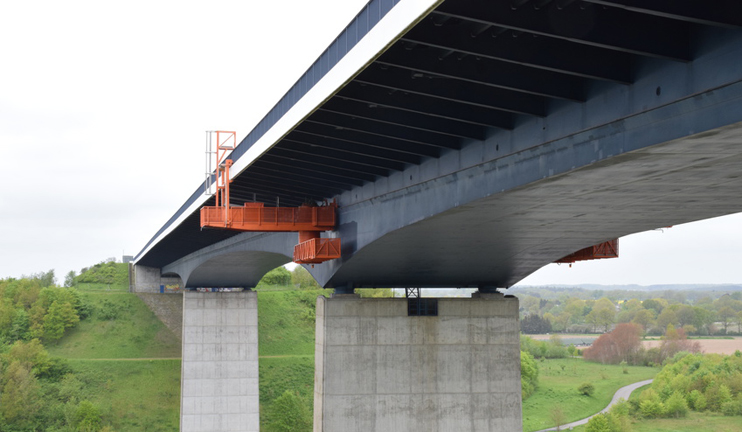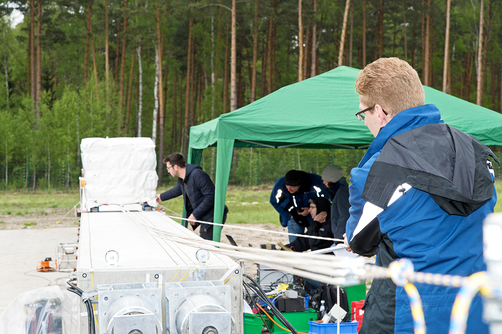
Maintenance works on bridges are time-consuming and cost-intensive.
Source: Fotolia.de/hydebrink
The dilapidated state of many bridges in Germany regularly hits the headlines. Most of Germany's approximately 39,000 motorway bridges were built between the 1960s and 1980s out of reinforced concrete. Today traffic levels are nearly twice as high. This means that the loads placed on these materials have increased significantly. In addition, road salt and the weather are particularly hard on the concrete.
A model bridge with sensors
The model bridge in the middle of a forest in the south of Berlin is 25 metres long and made of concrete. A special vehicle for heavy loads with two hefty weights drives slowly back and forth over the bridge, subjecting the road to two times 2 tonnes of pressure. There are dozens of wires and measuring tools protruding from the concrete, and BAM’s high-performance cameras record every movement. A machine makes the bridge vibrate to simulate daily road traffic while a group of scientists carefully follows the process. The bridge is located on BAM’s Test Site for Technical Safety (TTS) in Horstwalde and the experiments are intended to provide information on its condition and to train the measuring systems that track the damage development.
“We can use different methods simultaneously on this reference bridge to determine potential damage,” says Dr. Jörg Unger, who has the project lead. Seven BAM divisions are participating, as well as colleagues from the Netherlands Organisation for Applied Scientific Research (TNO). This could never be accomplished on a real bridge in traffic. “This would require far too much effort,” says Unger. “We also need sufficient prior knowledge about the construction of the bridge to enable us to evaluate the results.” And there is another problem: the owners of a bridge would hardly consent to the researchers damaging the structure.

Tests simulate traffic loads on the reference bridge: cable pull systems move metal weigthts back and forth over the bridge
Source: BAM
Live monitoring and early forecasts
The condition of a bridge nowadays is almost always evaluated by visual tests. “Modern optical methods, fibre optic sensors, inclination sensors and measurement of acoustic signals or vibration characteristics, which we use at BAM, have not yet been established,” says Unger. When assessing the safety of structures, BAM’s scientists are not only simply exploring these and other measurement methods. They also want to develop computer models that enable reliable predictions for the future. “If we could make early predictions about the aging process we might be able to avoid damage and reduce repair costs”, says Unger. Validated models could provide important decision-aiding tools, even if the bridge has already been damaged. How much will a small crack increase? How quickly does corrosion propagate? The answers to these and similar questions help prioritise renovation measures and plan further inspections. In addition, the innovative technology could enable the live monitoring of bridges, whose conditions are constantly monitored by built-in sensors.
Sensors detect cracks
The bridge in Horstwalde was equipped with appropriate measuring equipment at the time it was built. BAM’s research teams installed fibre optic cables along the steel reinforcement to enable fibre optic measurements. This method was newly developed within the project’s framework and could be used for vibration analysis in existing structures to gain additional safety information. The fibre optic cables act as sensors and measure the expansion that occurs if the material is under strain along the structure’s full length. “Any cracks are reflected by the measurement results,” explains Unger.

Technical monitoring: working with measurement devices
Source: BAM
In their efforts to better detect cracks, BAM has developed a sensor that can be embedded into the concrete, thus allowing the small device to listen to the bridge. “Every small micro crack produces an acoustic signal that sensors hear and can localise at various points,” says Unger about the measurement technology. But bridges are a difficult terrain for this technology, because traffic, road construction and other effects already produce intense noises. “We are trying to filter out the background noise to better identify the typical signals of the damage,” he explains. The researchers are also evaluating whether these and other ideas could be suitable for everyday use.
Control from inside and outside
The bridge in Horstwalde is not only observed from within, but also from the outside. A high-resolution camera records every change. “The camera’s images capture deformations that show how the bridge reacts under traffic load,” explains Unger. If the researchers use a high-speed camera, they can even track individual vibrations of the bridge. “We will evaluate whether such complex monitoring is viable for any structure,” says the researcher. The potential is great. “We expect that the combination of these methods will provide additional information that cannot be gained through individual measurements,” says Unger.
Horstwalde is not the only place where BAM’s sensors are being used. In Berlin, BAM’s technology has been used for over 20 years to metrologically monitor one of the busiest motorway bridges in Germany on the A100.


